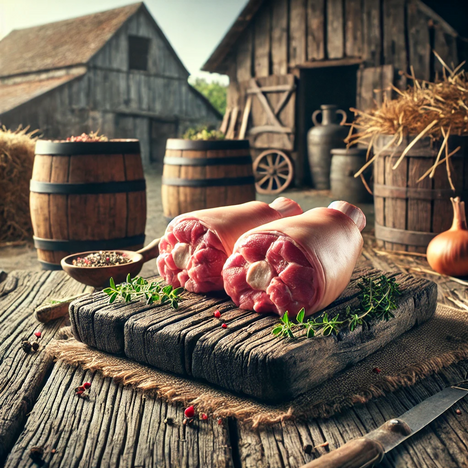Pork knuckles

The nutrition of our dogs is a constant focus of discussion and research. One particular topic that is of interest to many dog owners concerns the suitability of pork knuckles as part of a dog's diet. In this article, we take a closer look at pork knuckles and shed light on what they are, what advantages and disadvantages they have, and what you should bear in mind when feeding them.
What are pork shanks?
Pork shanks, also known as knuckle of pork, are the lower legs of the pig, more precisely the area between the foot and the knee joint. This part of the pig is particularly rich in connective tissue, bone, fat and skin. In a culinary context, pork shanks are particularly popular in German cuisine, where they are traditionally served roasted or braised.
Nutritional and physiological considerations
Before we turn to the specific advantages and disadvantages, it is important to take a look at the nutritional aspects of pork knuckles. In general, they contain proteins, fats, minerals and vitamins that are potentially beneficial for dogs. However, their suitability as dog food depends on various factors.
Benefits of pork knuckles for dogs
- High protein content:Protein is essential for building and maintaining muscle mass in dogs. Pork shanks can be a valuable source of protein here.
- Minerals and vitamins:Bones and connective tissue in particular are rich in minerals such as calcium and phosphorus, which are important for healthy bones and teeth. Vitamins can also be present in small amounts.
- Occupation and teeth cleaning: Chewing on hard bones can help clean teeth and provides a meaningful activity that appeals to a dog's natural chewing instinct.
Disadvantages of pork knuckles for dogs
- Risk of bone splinters: Cooked or roasted bones can splinter and lead to oral injuries or worse gastrointestinal complications.
- High fat content: The high fat content in pork shanks can lead to obesity and associated health problems if consumed in excess.
- Risk of pork-specific pathogens: Raw pork can contain pathogens such as the Aujeszky's virus, which can be fatal to dogs. Special care should therefore be taken.
Recommendations and precautions
If you are considering feeding your dog pork shank, here are some recommendations and precautions to keep in mind:
- Raw vs. Cooked: Avoid raw pork due to the risk of pathogens. Cooked shanks should also be handled with care as they can splinter.
- Moderation is key:Pork shanks should only be fed in moderation to minimize the risk of obesity and other health problems.
- Monitoring: Always monitor your dog when chewing on bones to identify any problems immediately.
Pork knuckles can be a tasty and nutritious addition to your dog's diet if prepared correctly and offered in moderation. However, it is important to consider the potential risks and take appropriate precautions to ensure the health and safety of your four-legged friend. Ultimately, the decision to feed pork knuckles should always be made with your dog's individual needs and health in mind.
If you notice any signs of hypersensitivity or poisoning in your dog, you should see your vet immediately. We are not a substitute for a vet, but we try to be as accurate as possible. Every dog reacts differently and we recommend you get a second opinion or consult your vet if in doubt.
Stay healthy and take good care of your four-legged friend!😊